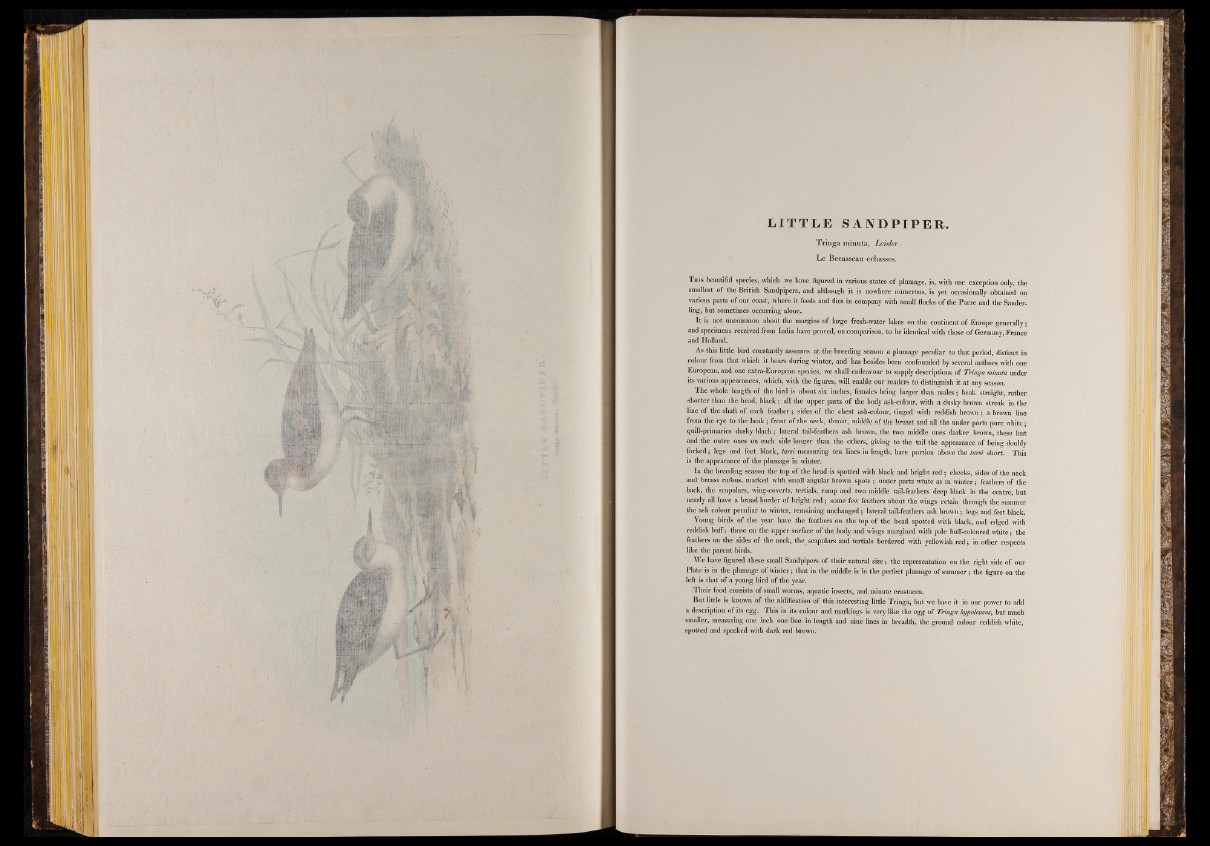
I I
SlISWa
L I T T L E SANDP I PE R .
T r in g a minuta, L e isle r .
L e Beca sseau echasses.
T h is beautiful species, which we have figured in various states o f plumage, is, with one exception only, the
smallest o f the British Sandpipers, and although it is nowhere numerous, is yet occasionally obtained on
various parts o f our coast, where it, feeds and flies in company with small flocks o f the Purre and the Sander-
ling, but sometimes occurring alone.
It is not uncommon about the margins o f large fresh-water lakes on the continent o f Europe generally;
and specimens received from India have proved, on comparison, to be identical with those o f Germany, France
and Holland.
As this little bird constantly assumes at the breeding season a plumage peculiar to that period, distinct in
colour from that which it bears during winter, and has besides been confounded by several authors with one
European, and one extra-European species, we shall endeavour to supply descriptions o f Tringa minuta under
its various appearances, which, with the figures, will enable our readers to distinguish it at any season.
The whole length o f the bird is about six inches, females being larger than males; beak straight, rather
shorter than the head, black; all the upper parts o f the body ash-colour, with a dusky brown streak in the
line o f the shaft o f each feather; sides o f the chest ash-colour, tinged with reddish brown; a brown line
from the eye to the b eak ; front o f the neck, throat, middle o f the breast and all the under parts pure white;
quill-primaries dusky black; lateral tail-feathers ash brown, the two middle ones darker brown, these last
and the outer ones on each side longer than the others, giving to the tail the appearance o f being doubly
forked; legs and feet black, tarsi measuring ten lines in length, bare portion above the tarsi short. This
is the appearance o f the plumage in winter.
In the breeding season the top o f the head is spotted with black and bright red ; cheeks, sides o f the neck
and breast rufous, marked with small angular brown spots ; under parts white as in winter; feathers o f the
back, the scapulars, wing-coverts, tertials, rump and two middle tail-feathers deep black in the centre, but
nearly all have a broad border o f bright red ; some few feathers about the wings retain through the summer
the ash colour peculiar to winter, remaining unchanged; lateral tail-feathers ash brown; legs and feet black.
Young birds o f the year have the feathers on the top o f the head spotted with black, and edged with
reddish buff; those on the upper surface o f the body and wings margined with pale buff-coloured white; the
feathers on the sides o f the neck, the_ scapulars and tertials bordered with yellowish red ; in other respects
like the parent birds.
We have figured these small Sandpipers o f their natural size; the representation on the right side o f our
Plate is in the plumage o f w inter; that in the middle is in the perfect plumage o f summer; the figure on the
left is that o f a young bird o f the year.
Their food consists of small worms, aquatic insects, and minute Crustacea.
But little is known o f the nidification o f this interesting little Tringa, but we have it in our power to add
a description o f its egg. This in its colour and markings is very like the egg o f Tringa hypoleucos, but much
smaller, measuring one inch one line in length and nine lines in breadth, the ground colour reddish white,
spotted and specked with dark red btown.